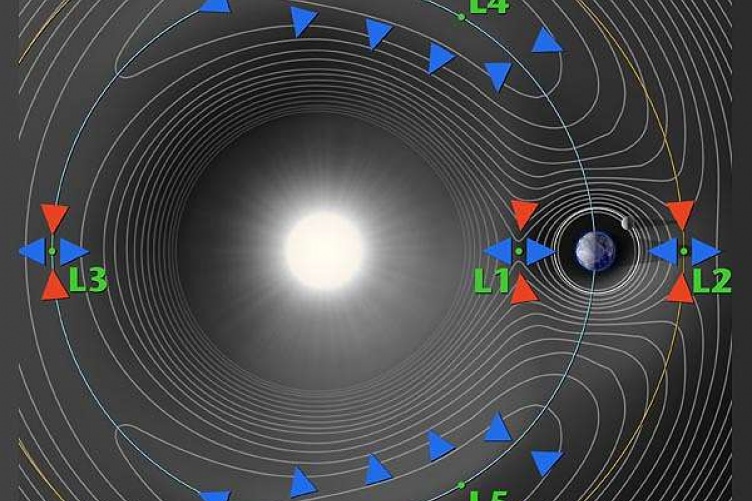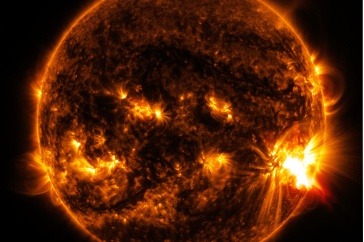
A new satellite will monitor space weather from Lagrange point 1 (L1) between the Sun and the Earth. Image credit: NASA
NASA and NOAA have selected a team of UNH researchers to design and build a specialized magnetometer to improve satellite-based space weather monitoring and forecasting capabilities. UNH will receive approximately $6 million for its part in the upcoming Space Weather Follow-On Lagrange 1 (SWFO-L1) mission.
A team of eight researchers and one student from the UNH Space Science Center and the Southwest Research Institute’s Earth, Oceans, and Space Office (SwRI-EOS) based at UNH will create a magnetometer that will be part of the SWFO-L1 satellite’s solar wind instrument suite, which measures the sun’s magnetic fields that have extended into space and will eventually intersect with Earth’s magnetic fields to drive magnetic storms.
“UNH has a very good legacy of magnetic sensor design, and this is building on its success in the electronics part of the instrument from the MMS mission,” explains Roy Torbert, UNH professor of physics and the lead PI on the magnetometer portion of the mission. “With this magnetometer, we’ll be able to measure how the Earth’s magnetic field is impacted by the solar wind.”
"It's a really huge win for UNH and SwRI-EOS that NOAA has selected and entrusted us as a partner for this key measurement."
Scientists have long sought to better understand and predict space weather storms from the solar wind, which pose health threats to astronauts in space and can affect electrical grids, satellite communications, and GPS navigation on Earth. NOAA and other organizations have monitored space weather via satellites for years; the suite of instruments on SWFO-L1, including UNH’s magnetometer, will improve upon some aging technology currently on other satellites while providing new methods to measure the solar wind. Ultimately, scientists hope this will help them to predict solar storms that could impact life on Earth.
The SWFO-L1 satellite will orbit the sun approximately 1.5 million kilometers from the Earth at a point scientists call Lagrange Point 1 (L1), which will allow for an unobstructed view of the sun’s corona, the source of the solar wind, for improved data collection. A spacecraft located at L1 can also directly measure the solar wind plasma and the interplanetary magnetic field about an hour before they reach the Earth, explains Harlan Spence, director for the UNH Institute for the Study of Earth, Oceans, and Space.
“That advanced warning is important for all sorts of industries that are affected by geospace storms and helps drive predictive models, such as one we are developing in partnership with the Johns Hopkins University Applied Physics Laboratory as part of NASA’s DRIVE program,” he says. “It’s a really huge win for UNH and SwRI-EOS that NOAA has selected and entrusted us as a partner for this key measurement.”
The SWFO-L1 mission is scheduled to launch in 2024 along with NASA’s IMAP mission, which UNH scientists are also involved in.
The Institute for the Study of Earth, Oceans, and Space (EOS) is UNH’s largest research enterprise, comprising six centers with a focus on interdisciplinary, high-impact research on Earth and climate systems, space science, the marine environment, seafloor mapping, and environmental acoustics. With more than $43 million in external funding secured annually, EOS fosters an intellectual and scientific environment that advances visionary scholarship and leadership in world-class research and graduate education
-
Written By:
Rebecca Irelan | Institute for the Study of Earth, Oceans, and Space | rebecca.irelan@unh.edu | 603-862-0990



















































